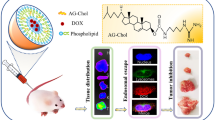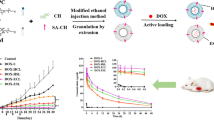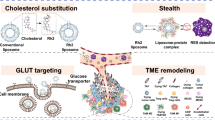Abstract
The effect of incorporation of cholesterol (CH) into liposome membranes on the delivery of 67Ga encapsulated in liposomes to tumors was studied. The changes of the blood clearance of liposomes, liposome, stability in serum and liposome uptake by the liver and spleen were also examined. Liposomes were prepared from distearoylphosphatidylcholine with various amounts of CH. It became clear that large amounts of CH (above 33 mol%) dramatically enhanced liposomal delivery of 67Ga to sarcoma 180 solid tumor in mice. Large amounts of CH increased the liposome stability in serum and decreased liposome uptake by the liver and spleen after intravenous injection, thus prolonging the blood clearance of liposomes. These observations suggested that the large delivery of 67Ga by CH-rich liposomes resulted from the extended retention and increased amount of liposomes in the circulation, caused by the incorporation of large amounts of CH. Small amounts of CH decreased liposome stability and hastened blood clearance, but had little effect on 67Ga delivery to the tumor. CH-rich liposomes showed high tumor uptake, with high tumor to blood and tumor to tissue ratios, of 67Ga. It is anticipated that 67Ga-carrying liposomes will be an excellent tumor imaging agent for clinical use, provided that a correct choice of CH content is made.
Similar content being viewed by others
References
Abraham I, Gondalkar A, Mezei M (1984) Effect of liposomal surface charge on the pharmacokinetics of an encapsulated model compound. Biopharm Drug Dispos 5:387–398
Agrarwal K, Bali A, Gupta CM (1986) Influence of the phospholipid structure on the stability of liposomes in serum. Biochim Biophys Acta 856:36–40
Copeland BR, McConnel HM (1980) The rippled structure in bilayer membranes of phosphatidylcholine and binary, mixtures of phosphatidylcholine and cholesterol Biochim Biophys Act 599:95–109
Demel RA, De Kruyff B (1976) The function of sterols in membranes. Biochim Biophys Acta 457:109–132
Gotfredsen CF, Frokjaer S, Hjorth, EL, Jorgensen KD, Debroux-Guisset M (1983) Disposition of intact liposomes of different compositions and of liposomal degradation products. Biochem Pharmacol 32:3381–3387
Green R, Widder KJ (1987) Drug and enzyme targeting. Part B. Section II. Liposome carriers. Methods Enzymol 149:51–216
Gregoriadis G, Kirby C, Senior J (1983) Optimization of liposome behavior in vivo. Biol Cell 47:11–18
Johnson SM (1973) The effect of charge and cholesterol on the size and thickness of sonicated phospholipid vesicles. Biochim Biophys Acta 307:27–41
Kirby C, Gregoriadis G (1981) Plasma-induced release of solutes from small unilamellar liposomes associated with pore formation in the bilayers. Biochem J 199:251–254
Lentz BR, Barrow DA, Hoechili M (1980) Cholesterol-phosphatidylcholine interactions in multilamellar vesicles. Biochemistry 19:1943–1954
Machy P, Leserman L (1987) Liposomes in cell biology and pharmacology. John Libbey Eurotext, Blanche, Montrouge, France
Ogihara I, Kojima S, Jay M (1986a) Tumor uptake of 67Ga-carrying liposomes. Eur J Nucl Med 11:405–411
Ogihara I, Kojima S, Jay M (1986b) Differential uptake of gallium-67-labeled liposomes between tumors and inflammatory lesions in rats. J Nucl Med 27:1300–1307
Ogihara-Umeda I, Kojima S (1988) Increased delivery of gallium-67 to tumors using serum-stable liposomes. J Nucl Med 29:516–523
Patel HM, Tuzel NS, Ryman BE (1983) Inhibitory effect of cholesterol on the uptake of liposomes by liver and spleen. Biochim Biophys Acta 761:142–151
Rosa P, Clementi F (1983) Absorption and tissue distribution of doxorubicin entrapped in liposomes following intravenous or intraperitoneal administration. Pharmacology 26:221–229
Scherphof G, Damen J, Hoekstra D (1981) Interactions of liposomes with plasma proteins and components of the immune system. In: Knight CG (ed) Liposomes: from physical structure to therapeutic applications Elsevier, Amsterdam, pp 300–322
Scherphof GL, Damen J, Wilschut J (1984) Interactions of liposomes with plasma proteins In: Gregoriadis G (ed) Liposome technology. Vol. 3. Targeted drug delivery and biological interaction. CRC Press, Florida, pp 205–224
Senior J, Crawley JCW, Gregoriadis G (1985) Tissue distribution of liposomes exhibiting long half-lives in the circulation after intravenous injection. Biochim Biophys Acta 839:1–8
Storm G, Roerding FH, Steerenberg PA, de Jong WH, Crommelin DJA (1987) Influence of lipid composition on the antitumor activity exerted by doxorubicin-containing liposomes in a rat solid tumor model. Cancer Res 47:3366–3372
Author information
Authors and Affiliations
Rights and permissions
About this article
Cite this article
Ogihara-Umeda, I., Kojima, S. Cholesterol enhances the delivery of liposome-encapsulated gallium-67 to tumors. Eur J Nucl Med 15, 612–617 (1989). https://doi.org/10.1007/BF00256940
Received:
Accepted:
Issue Date:
DOI: https://doi.org/10.1007/BF00256940




